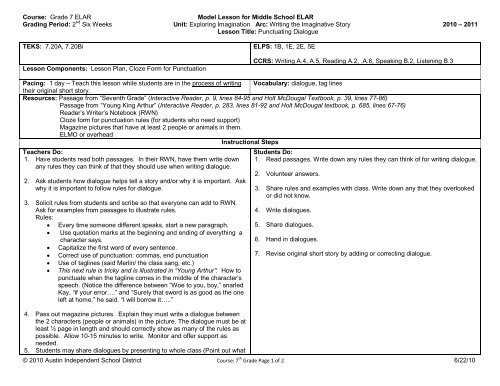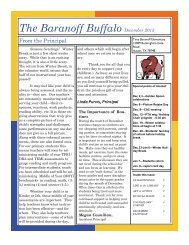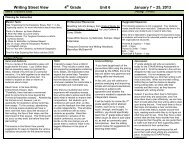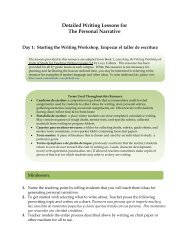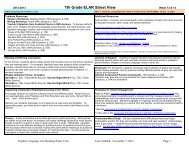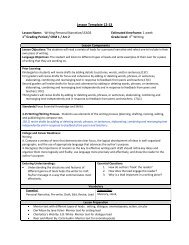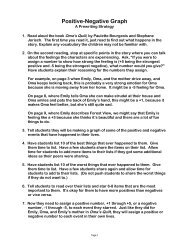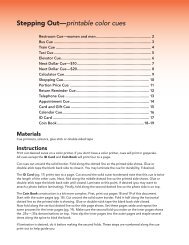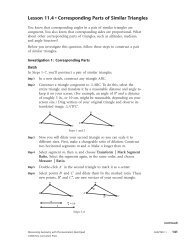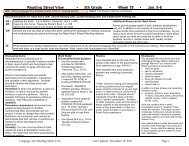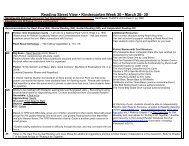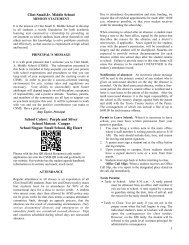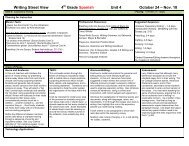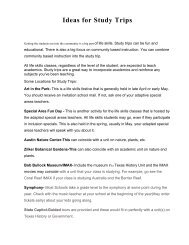ELPS: 1B, 1E, 2E, 5E
ELPS: 1B, 1E, 2E, 5E
ELPS: 1B, 1E, 2E, 5E
- No tags were found...
Create successful ePaper yourself
Turn your PDF publications into a flip-book with our unique Google optimized e-Paper software.
Course: Grade 7 ELARModel Lesson for Middle School ELARGrading Period: 2 nd Six Weeks Unit: Exploring Imagination Arc: Writing the Imaginative Story 2010 – 2011Lesson Title: Punctuating DialogueTEKS: 7.20A, 7.20BiLesson Components: Lesson Plan, Cloze Form for Punctuation<strong>ELPS</strong>: <strong>1B</strong>, <strong>1E</strong>, <strong>2E</strong>, <strong>5E</strong>CCRS: Writing A.4, A.5, Reading A.2, .A.8, Speaking B.2, Listening B.3Pacing: 1 day – Teach this lesson while students are in the process of writing Vocabulary: dialogue, tag linestheir original short story.Resources: Passage from “Seventh Grade” (Interactive Reader, p. 9, lines 84-95 and Holt McDougal Textbook, p. 39, lines 77-86)Passage from “Young King Arthur” (Interactive Reader, p. 283, lines 81-92 and Holt McDougal textbook, p. 685, lines 67-76)Reader’s Writer’s Notebook (RWN)Cloze form for punctuation rules (for students who need support)Magazine pictures that have at least 2 people or animals in them.ELMO or overheadInstructional StepsTeachers Do:1. Have students read both passages. In their RWN, have them write downany rules they can think of that they should use when writing dialogue.2. Ask students how dialogue helps tell a story and/or why it is important. Askwhy it is important to follow rules for dialogue.3. Solicit rules from students and scribe so that everyone can add to RWN.Ask for examples from passages to illustrate rules.Rules:• Every time someone different speaks, start a new paragraph.• Use quotation marks at the beginning and ending of everything acharacter says.• Capitalize the first word of every sentence.• Correct use of punctuation: commas, end punctuation• Use of taglines (said Merlin/ the class sang, etc.)• This next rule is tricky and is illustrated in “Young Arthur”: How topunctuate when the tagline comes in the middle of the character’sspeech. (Notice the difference between “Woe to you, boy,” snarledKay, “if your error….” and “Surely that sword is as good as the oneleft at home,” he said. “I will borrow it…..”4. Pass out magazine pictures. Explain they must write a dialogue betweenthe 2 characters (people or animals) in the picture. The dialogue must be atleast ½ page in length and should correctly show as many of the rules aspossible. Allow 10-15 minutes to write. Monitor and offer support asneeded.5. Students may share dialogues by presenting to whole class (Point out whatStudents Do:1. Read passages. Write down any rules they can think of for writing dialogue.2. Volunteer answers.3. Share rules and examples with class. Write down any that they overlookedor did not know.4. Write dialogues.5. Share dialogues.6. Hand in dialogues.7. Revise original short story by adding or correcting dialogue.© 2010 Austin Independent School District Course: 7 th Grade Page 1 of 2 6/22/10
Course: Grade 7 ELARModel Lesson for Middle School ELARGrading Period: 2 nd Six Weeks Unit: Exploring Imagination Arc: Writing the Imaginative Story 2010 – 2011Lesson Title: Punctuating Dialoguethey did correctly.) Another option would be to have them share in pairsand provide them with a feedback sheet that helps correct any errors.6. Collect dialogues (It is helpful to attach pictures.) to assess who hasmastered the rules and who will need additional support.7. Send students into their drafts of their original short stories they are writingand add/correct dialogue.Differentiated Instruction:• Cloze form for students who need support.• McDougal Online textbook offers a tutorial that students can complete alone or in class with teacher supervision. (Go to Online textbook, Unit 3-Understanding Theme Writing Workshop (Short Story). Choose either Student or Teacher Resources. Under “Online Extras,” choose Grammar Notes,Using Quotation Marks. Within the power point is an interactive Tutorial on Dialogue.Evidence of LearningObservation: Monitor of independent writingFormative Assessment:Student Work Products/Rubric: Short Dialogue/ dialogue added correctly into student’s own short storySummative Assessment/Rubric:Other: Teacher evaluation of student responses (oral and written)© 2010 Austin Independent School District Course: 7 th Grade Page 2 of 2 6/22/10
Reader’s Writer’s NotebookDefinitionsPunctuation Rules and Examples1. Rule: Every time someone different speaks, start a new paragraph.Example: _______________________________________________________________________________________________________________________________________________________________2. Rule: Use quotation marks at the beginning and ending of everything the character says.Example: ___________________________________________________________________________3. Rule: Capitalize the first word of every sentence.Example: __________________________________________________________________________4. Rule: Correct use of punctuation: commas, end punctuationExamples:___________________________________________________________________________5. Rule: Use punctuation and capitalization correctly when you are telling who the speaker is.(saidMerlin/ the class sang, etc.)Examples_______________________________________________________________________________________________________________________________________________________________
Reader’s Writer’s NotebookDefinitions6. Rule: When you interrupt what a character says to tell who the character is, use punctuationand capitalization rules correctly.Example: (when you interrupt the character in the middle of his or her sentence)Example: (when you interrupt a character in between his or her sentences)________________________________________________________________________________
Dialogue RubricDialogueFocus onAssignedTopicCharactersCreativityConventions4 3 2 1There are 18 – 20 linesof dialogue.The entire dialogue isrelated to the assignedtopic and allows thereader to understandmuch more about thesubject.The main characters arenamed and clearlydescribed in text. Thecharacters’ opinions areeasy to identify.The story contains manycreative details and/ordescriptions. Thewriting was imaginative.There are no errors withspelling, punctuation, orgrammar in the finaldraft.There are 16 – 17 linesof dialogue.Most of the dialogue ison topic and helps thereader learn about thesubject.Two of the threedescriptions were met.1. Characters arenamed.2. Characters aredescribed.3. Characters’opinions areeasily identified.The story contains a fewcreative details and/ordescriptions. Thewriting showed someimagination.There are only a fewerrors with spelling,punctuation, andgrammar in the finaldraft.There are 14 – 15 linesof dialogue.Some of the dialogue isrelated to the assignedtopic, but a reader doesnot learn much aboutthe subject.The main characters arenamed. The readerknows very little aboutthe characters.The story contains a fewcreative details and/ordescriptions, but theydistract from the story.The writing showed littleimagination.There are several errorswith spelling,punctuation, andgrammar in the finaldraft.There is little to nodialogue in the text.No attempt has beenmade to relate the storyto the assigned topic.It is hard to tell who themain characters are.There is little evidenceof creativity in the story.The writer does notseem to have usedmuch imagination.Spelling, punctuation,and grammar needmuch more editingbefore final publication.


